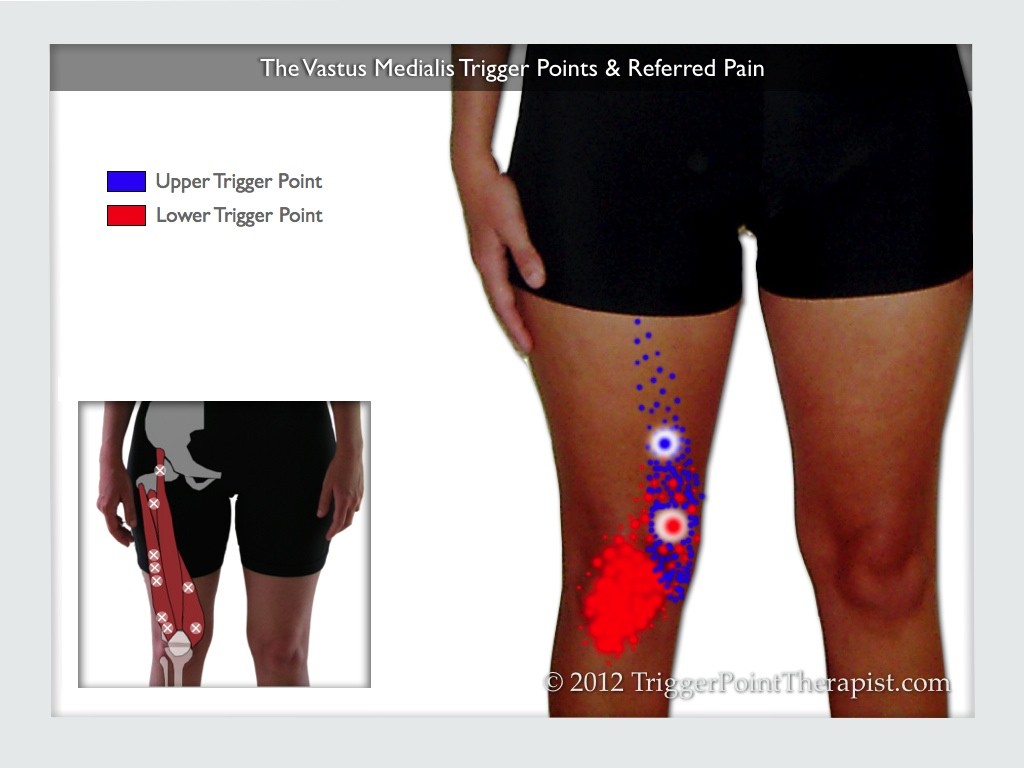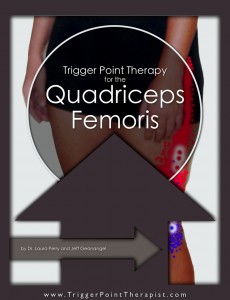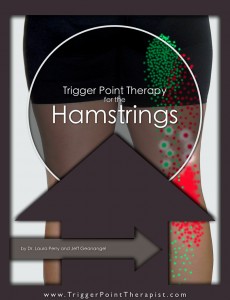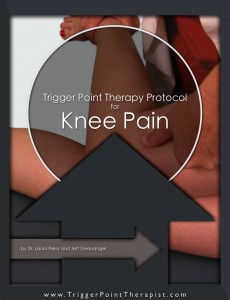The Buckling Knee Trigger Point
Trigger points in three of the four quadricep muscles can produce knee pain complaints. This is part three in a series of articles on the knee pain trigger points, and it covers the vastus medialis muscle and its trigger points.
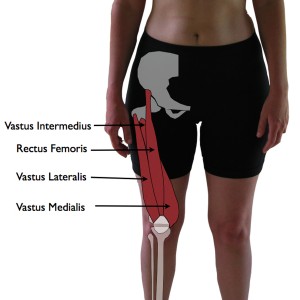 The vastus medialis trigger points refer a toothache-like pain deep in the knee joint that may disappear after a few weeks, only to be replaced by a sudden weakness in the knee (a condition called “buckling knee”) that causes a person to unexpectedly fall while walking.
The vastus medialis trigger points refer a toothache-like pain deep in the knee joint that may disappear after a few weeks, only to be replaced by a sudden weakness in the knee (a condition called “buckling knee”) that causes a person to unexpectedly fall while walking.
These quadriceps trigger points are very prominent in sporting activities that require a lot of running, like soccer, basketball, football, and track and field.
Over time, chronic trigger point activity in this muscle may cause damage to the knee joint itself, so regular treatment of these trigger points becomes very important for clients with knee pain complaints.
The Vastus Medialis Muscle
Location: The quadriceps femoris muscle group form the thigh musculature found on the front of the upper leg. The group is comprised of four muscles:
- The Vastus Lateralis muscle is found along the outside of the thigh.
- The Rectus Femoris muscle is found along the centerline of the thigh.
- The Vastus Medialis muscle is found along the inside of the thigh.
- The Vastus Intermedius muscle is found deep to the rectus femoris muscle along the centerline of the thigh.
Function: In everyday life, the quadricep muscle group as a whole functions to allow a person to squat, bend backwards, walk up or down stairs, and move from a standing to a seated position (or vice-versa). These muscles are not active while standing with the knees locked, but become active during the heel-strike and toe-off phases of walking and running.
Muscle Structure and Actions: The vastus medialis muscle originates along almost the entire length of the shaft of the femur (on the back of the shaft), traveling down the inside of the thigh to attach to the medial aspect of the patella bone. Contraction of this muscle produces knee extension.
Synergistic Muscles: All of the quadricep muscles act together to produce knee extension, so the vastus medialis muscle is assisted by the vastus lateralis and rectus femoris muscles during it’s contraction. Trigger point activity can easily spread between the muscles in the quadriceps group.
Antagonistic Muscles: The primary muscles that oppose the knee extension produced the quadriceps are the hamstring and gastrocnemius muscles. Contraction of the vastus medialis and vastus lateralis can exert opposing medial and lateral pulls on the patella, and must be coordinated to allow for proper patellar tracking during movement of the knee.
The Vastus Medialis Trigger Points and Referred Pain
There are two trigger points that can occur in the vastus medialis muscle.
- The lower vastus medialis trigger point is this more common of the two, and is found just above and to the inside of the knee joint. It refers an aching pain to the front of the knee that may extend up into the lower medial thigh region. After a few weeks, the pain from this trigger point can diminish, but is replaced by unexpected weakness in the muscle that causes the knee to suddenly buckle while a person is walking.
- The upper vastus medialis trigger point is found a few inches above the lower trigger point, on the inside aspect of the lower thigh. It refers pain down the inside of the thigh to just above the knee.
What Causes Vastus Medialis Trigger Points?
The following events or activities may activate or reactivate these quadricep trigger points:
- The quadriceps muscle group as a whole are typically overloaded by “catching oneself” after stumbling or unexpectedly stepping into a hole. In these situations the muscles undergo a strong eccentric (lengthening) contraction as they try to decelerate the body’s full weight during the fall.
- A new exercise program that includes squats or deep knee bends may also overload these muscles.
- Unaddressed trigger point activity in the hamstrings can cause chronic tightness in these muscles. As the biomechanical counterpart to the hamstrings, the quadriceps will frequently develop trigger point activity in response to the chronic muscle tension in the hamstrings.
- Clients that have tension in their soleus muscle will often compensate for this when trying to squat down and lift something by overloading their quadricep muscles. The tight soleus prevents them from flexing their ankle (dorsiflexing) properly while squatting down.
- Skiing, and skiing accidents, are particularly hard on the quadricep muscles muscles in general.
- Trigger point activity in the vastus medialis is seen more frequently in those people who excessively pronate their foot (toes outward) and in those people with Morton’s Foot Structure (see Related Disorders).
- Common sporting activities such as jogging, running, soccer, football, and basketball can also overload this muscle.
- Car accidents where the person’s knee strikes the steering wheel can activate the vastus medialis trigger points.
Vastus Medialis Symptoms & Disorders
Clients with active trigger points in this muscle will present with any of the following symptoms or clinical findings:
- Client’s complain of a toothache-like pain that they experience deep in the knee joint, particularly when trying to sleep.
- In time, they may also experience a buckling knee condition that is characterized by sudden weakness in the knee while walking that causes them to fall.
- The toes on the foot of the affected leg will frequently be pointed to the outside (pronation).
Related Knee Pain Disorders
- Knee Joint Injury: Strains or tears of the ligaments and menisci are quite common in professional and recreational sports. As with any joint, the knee joint structures are susceptible to abnormal stress from chronic tension in the muscles that move the joint (i.e. the quadricep, hamstring, and gastrocnemius muscles). It is my opinion that many of these injuries could be avoided with some regular (maintenance) trigger point treatment to the vastus lateralis, vastus medialis, and hamstring muscles. I think this is especially true for the athletes at both ends of the conditioning spectrum (the poorly conditioned and highly conditioned athletes). Of course, many of these injuries occur from physical trauma to the leg and knee, and are thus unavoidable in the traditional sense.
- Patellofemoral Dysfunction: This condition is characterized by abnormal tracking on the knee cap (patella) during movements of the knee joint. The contraction of the vastus lateralis and vastus medialis muscles must be coordinated properly for the patella to track normally. Trigger points in either of these muscles can compromise this coordination, causing the knee cap to be displaced laterally.
- Phantom Limb Pain: Because the pain from trigger points is typically experienced in a another region of the body, it is often responsible for phantom limb pain in people that have had a limb amputated. These people may be told that their pain is “not real” and is fabricated in their mind, but in reality their pain is as real as anyone else’s pain and has its origin in trigger points in the remaining part of the limb or trunk. Referred pain doesn’t require the body part targeted by the pain to actually exist, as it’s just a neurological reflex designed to tell the brain to modify one’s physical activity so the muscle harboring the trigger point can rest and recover.
- Nerve Entrapment: Pain on the medial aspect of the knee may be caused by entrapment of the saphenous nerve.
- Morton’s Foot Structure: A variation of the boney structure of the foot where the base of the second toe (next to the big toe) is farther forward than the base of the big toe. Typically, a thick callus forms on the foot where the second toe attaches to it. This condition causes side-to-side rocking or instability of the foot and knee, and may overload the vastus medialis muscle as it tries to compensate for the knee instability.
- Growing Pains: Unexplained knee and thigh pain in children is often attributed to “growing pains” when trigger point activity in the quadriceps (and other muscles) is the real cause. Children are constantly pushing their bodies to new limits and can easily overload the leg muscles while playing.
Treatment of the Quadriceps Trigger Points
Effective treatment for knee pain complaints requires the therapist to locate and release the trigger points in the vastus lateralis, rectus femoris, and vastus medialis muscles together, which is why we have included all three muscles in the Trigger Point Therapy for Quadriceps Video + 23-page PDF Booklet.
You can watch a sample from the Quadricep Trigger Points video on YouTube by clicking on the video image below:
Related Articles:
- Rectus Femoris Trigger Point: The Knee Pain Trigger Points – Part 2
- Vastus Lateralis Trigger Points: The Knee Pain Trigger Points – Part 1
- The Hamstring Trigger Points: Hiding in Plain Sight
Related Instructional Videos:
